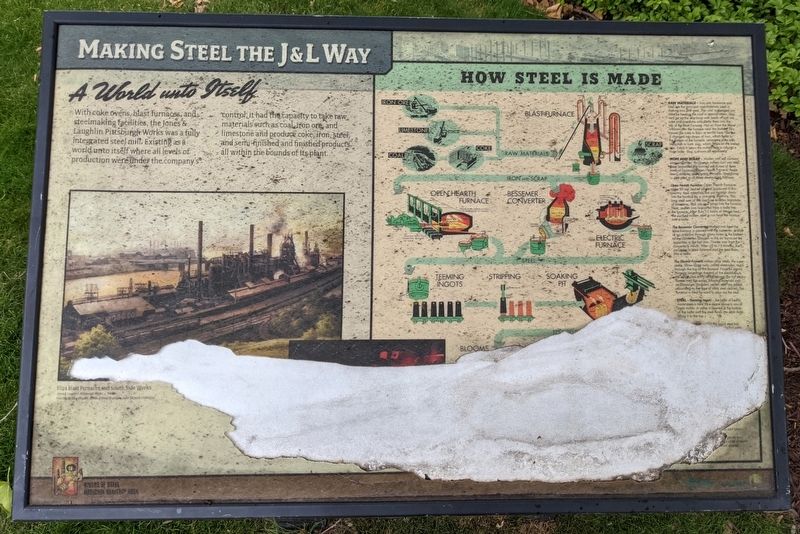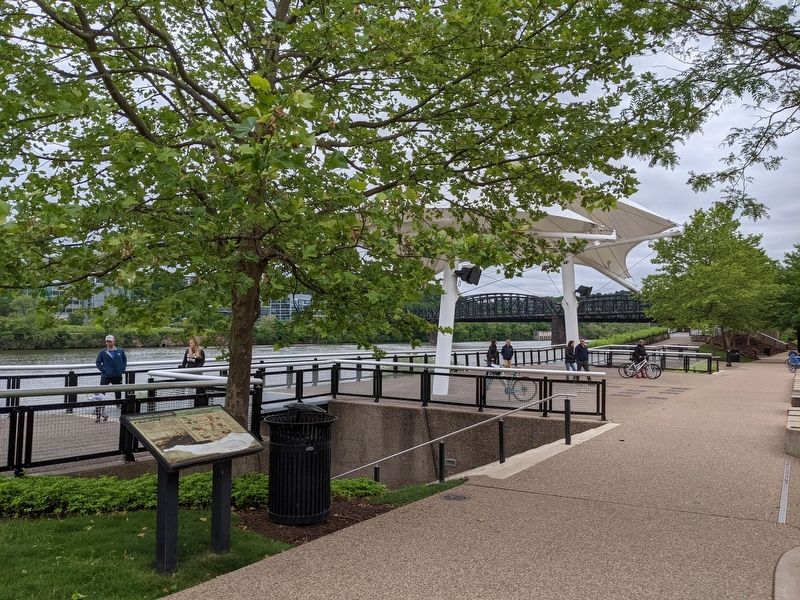Making Steel The J&L Way
With coke ovens, blast furnaces, and steelmaking facilities, the Jones & Laughlin Pittsburgh Works was a fully integrated steel mill. Existing as a world unto itself where all levels of production were under the company's control, it had the capacity to take raw materials such as coal, iron ore, and limestone and produce coke, iron, steel, and semi-finished and finished products all within the bounds of its plant.
How Steel Is Made
Raw Materials - Iron ore, limestone and coal are the principal raw materials used in making iron and steel. The coal is changed into coke by heating the coal in special ovens. Skip cars go up the skip hoist with loads of iron ore, coke and limestone and dump them into the top of the Blast Furnace. Hot air from the Stove is blown into the furnace near the bottom. This causes the coke to burn at terrific heat. The ore is changed into drops of iron, which settle to the bottom of the furnace. Limestone joins with impurities to form slag, which floats on the melted iron. Every 6 hours the molten iron is run into a huge ladle. Slag is drawn off separately.
Iron And Scrap - Molten iron still contains some impurities. To change molten iron into steel these impurities are burned out in one of three kinds of furnaces: Open Hearth Furnace, Bessemer
Converter and Electric Furnace. Steel Scrap is also used in all three steelmaking furnaces.Open Hearth Furnace: Open Hearth Furnaces make 90 percent of all steel produced in this country. Raw materials are put are put through doors into the furnace by a charging machine. The long steel arm of the machine empties boxloads of limestone, iron ore and scrap into the furnace. Next, molten iron is poured from a ladle into the furnace. After 8 to 12 hours of intense heat, the purified molten steel is run from the furnace into ladle.
The Bessemer Converter: Molten iron from the blast furnace is poured into the converter. A blast of air is blown through many holes in the bottom of the converter. Oxygen in the air burns out the impurities in the hot iron. Flames roar from the converter’s mouth. After 10 to 15 minutes, the converter is tilted forward and the steel flows into a ladle.
The Electric Furnace makes alloy steels, the super-steels. Three large rods, called electrodes, reach through the top of the furnace. Powerful electric current jumps from one end of the electrodes to the scrap, like artificial lightening. The hot electric flames melt the scrap. Alloying materials such as chromium, tungsten, nickel, etc., are added according to the type of alloy steel desired. The furnace is tilted forward to pour out the steel.
Steel – Teeming Ingots - the ladle of freshly made steel is held by a crane above a row of ingot molds. A valve is opened in the bottom of the ladle and the steel flows into each mold filling it to the top.
(caption)
Eliza Blast Furnaces and South Side Works Jones & Laughlin, Pittsburgh Works, c. 1960s Painting by John Shryock, Rivers of Steel Archives, John Shyock Collection
Erected by Rivers of Steel National Heritage Area.
Topics. This historical marker is listed in this topic list: Industry & Commerce.
Location. 40° 25.764′ N, 79° 57.892′ W. Marker has been damaged. Marker is in Pittsburgh, Pennsylvania, in Allegheny County. It is in the South Side Flats. Marker is on Three Rivers Heritage Trail, 0.2 miles west of Hot Metal Bridge, on the right when traveling west. Not accessible by motorized vehicle. Touch for map. Marker is at or near this postal address: 2700 S Water St, Pittsburgh PA 15203, United States of America. Touch for directions.
Other nearby markers. At least 8 other markers are within walking distance of this location. Shaping Steel (within shouting distance of this marker); Rivers of Steel (within shouting distance of this marker); Hub of Activity (about 300 feet away, measured in a direct line); Cast Iron Columns (about 300 feet away); Jones & Laughlin Steel Company
Credits. This page was last revised on February 2, 2023. It was originally submitted on June 2, 2021, by Bernard Fisher of Richmond, Virginia. This page has been viewed 383 times since then and 76 times this year. Photos: 1, 2. submitted on June 2, 2021, by Bernard Fisher of Richmond, Virginia.

